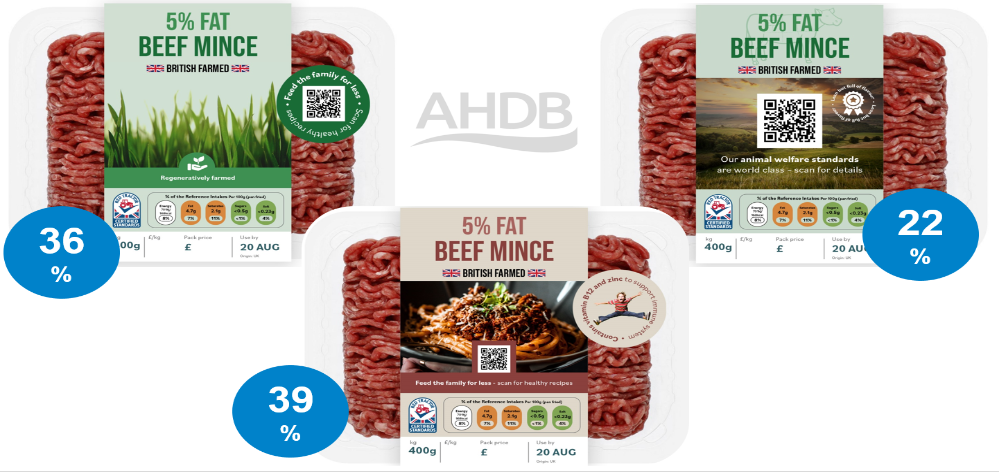- Home
- Hierarchy level 1 – Inspire with imagery and cooking details
Hierarchy level 1 – Inspire with imagery and cooking details
This research was undertaken by AHDB in collaboration with Basis Research with the aim to understand what shoppers are looking for on red meat packaging that could influence their purchase intent, including cooking inspiration and taste messages.
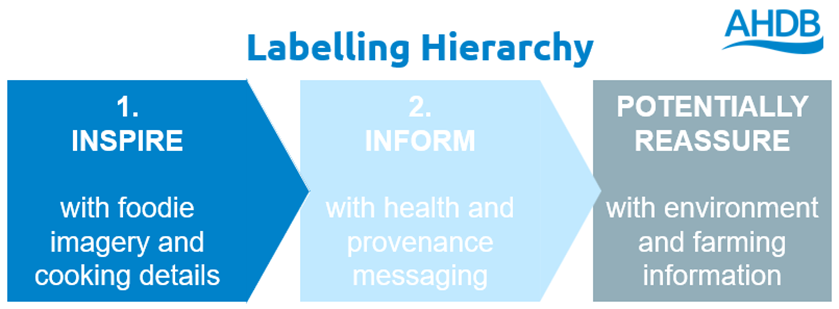
To identify which messages to include on new pack designs, we used the results from a Max Diff to test the hierarchy of key messages. From these results, we created a range of messages on health, animal welfare, environment, and cooking advice which could be included on pack. We also designed a baseline pack which did not include any messaging or imagery, similar to most standard meat packaging currently in use.
Examples of packs tested
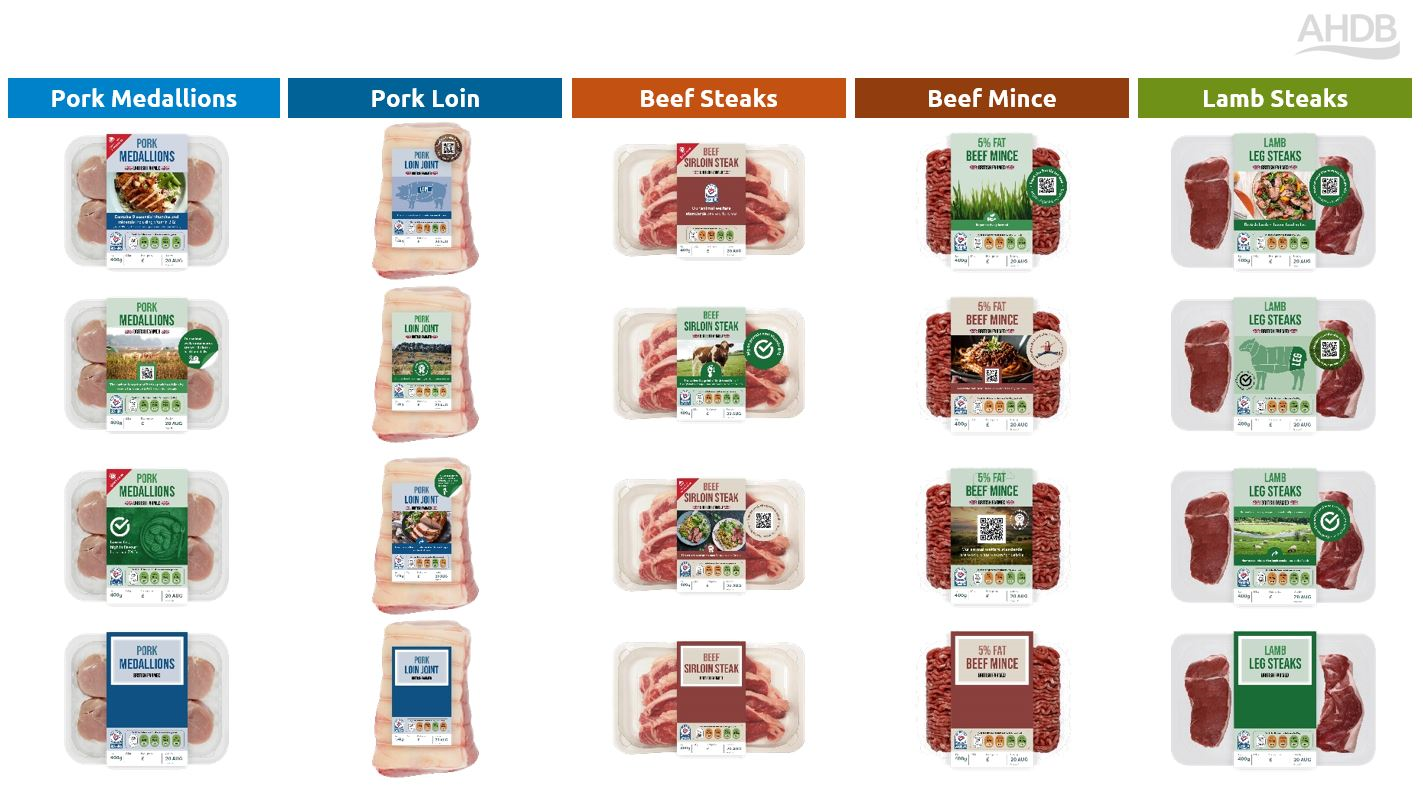
Strong food imagery preferred by shoppers
The results were consistent across the range of cuts and protein we tested. Labels which displayed clear food imagery were the best liked by shoppers. In the case of pork medallions, pork loins and beef steaks, more than half of shoppers selected the labels with foodie imagery as their favourite (64%, 57% and 56% respectively).
Product most likely to purchase from label by cut

However, it has to be the ‘right’ image used. In our online community we tested a pack showing a standard spaghetti Bolognese which received a lacklustre reaction. When we then showed a more imaginative image of mince in lettuce cups, this was then classed as a dish which people would not cook at home.
Examples of mince dishes tested
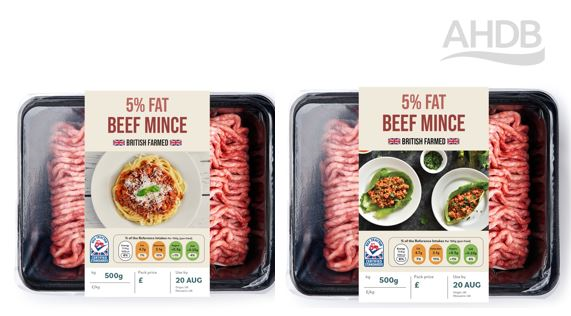
Finding the right balance of a dish which is interesting, inspiring and tasty looking, but also achievable for home cooks is key. We found that the best liked images included:
- A complete dish, particularly for mince or smaller cuts
- Visible, well cooked meat showing things such as herbs and caramelisation
- No visible fat showing, or additional ‘unhealthy’ cues
- An overall attractive ‘setting’ with good plate presentation
Shopper comments for labels tested
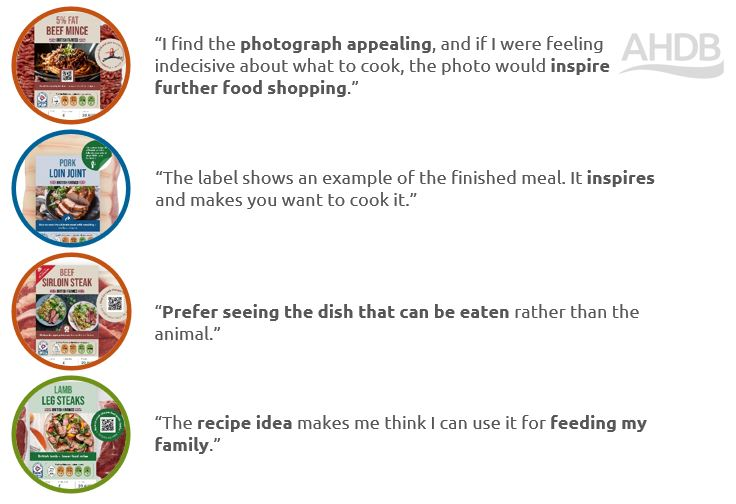
This was also highlighted in our message testing, as the most compelling taste and inspiration messages were about ‘how to cook the perfect’ product and quality guaranteed. This is in line with the results we found in our instore research.
These results were also backed up by the heat maps depicting what specifically appealed to shoppers about the labels, with the areas noted as being most appealing centring around the meal inspiration image used.
Heat maps indicating areas shoppers found most appealing on labels
When compared with the simple baseline packs, the food imagery labels saw an uplift in appeal between 33%-45%, and an increase in likelihood to purchase between 30%-36% across the products. We also saw an uplift versus the baseline with shoppers saying it was the images that made them want to buy the product between 28%-37%, and that the images provided an uplift in cooking inspiration between 44%-56%.
Beef mince saw less defined preference for inspiration on label
While the food imagery labelling option did come out as the preferred choice for beef mince, it was not such a clear winner. The mince food imagery labels saw some of the smallest uplifts against the baseline packs for the appeal testing. The labels it was tested against, one depicting grass with regenerative farmed messaging and one with animal welfare messaging, scored much closer than the other products tested, with the grass image with regenerative messaging coming in a very close second place.
Shopper preference for mince pack (% most liked)
We believe that the reason for the closeness in scores is due to most shoppers feeling confident in how to cook mince and incorporate it into a number of dishes. This means that inspiration is less influential in driving purchase intent for this cut when at fixture as it is more of a household staple. However, shoppers still preferred a reminder of the tasty dishes to create with it. When comparing to less familiar cuts, such as pork medallions, there is a much greater preference to the food imagery label as shoppers require cooking inspiration to give them the confidence to pick up the pack.
It was also apparent from the heat maps that for beef mince the fat content messaging was the most helpful piece of information on pack, and that British credentials are very appealing to shoppers which is discussed in more detail in the health and provenance sections. The interest in the regeneratively farmed message is also explored in the environment and sustainability section.
Shopper types have similar preferences
When we look at the favourite options across the different shopper types, the results were consistent with the food imagery coming out as the favourite. We did however see that convenience shoppers (such as Co-op, Nisa and Spar) were slightly more drawn to the foodie imagery, particularly for cuts they may be less familiar with such as lamb leg steaks and pork loin, which saw significant uplifts. This could be due to convenience shoppers shopping for their next meal rather than the whole weekly shop, and hence looking to be inspired by a new meal idea, rather than traditional weekly classics.
Meal inspiration images were also seen to be preferred for most cuts by both stable meat eaters and those classifying as cutting back. Beef mince was an exception, where the grass imagery and regenerative messaging was preferred by lighter mince shoppers, which will be covered further in the environment and sustainability section.
Cooking confidence messaging
While images are an eye catching and effective way to provide inspiration for shoppers on pack, they aren’t the only source that is looked for.
Each of the preferred label designs included references to cooking times, recipe ideas, or information on ‘how to cook the perfect…’ product. Shoppers liked these hints, particularly for larger cuts such as joints and steaks which can be cooked to different specifications.
|
How to cook the perfect… |
61% |
|
Quality guaranteed |
60% |
|
Low in fat, high in flavour |
56% |
|
30 days dry aged prime cuts for quality and flavour |
35% |
|
Feed the family for less |
35% |
|
Cooks in under 7 minutes |
33% |
|
Delicious dishes crafted by you |
32% |
|
Quick cook |
31% |
|
Be inspired |
26% |
|
A roast to remember |
25% |
Shoppers said information on cooking times and methods were important, and 66%* of shoppers claimed they would be encouraged to purchase by messaging on how to cook the perfect pork loin and the same for the lamb steak. These claims were thought to be less helpful for more straightforward cuts, such as beef mince, where familiarity and confidence in cooking methods are generally well established. However, the option to scan a QR code calling out healthy recipes to ‘feed the family for less’ were well liked.
Quality messaging also ranked highly with shoppers for all of the tested proteins and cuts. Reference to the quality and flavour of the product, such as ‘30 days dry aged prime cuts for quality and flavour’, would encourage purchase of beef steaks for 52%* of shoppers. Once again, selecting the ‘right’ image for the product is vitally important, as 91% of shoppers claimed that the most favoured labels with the visual appeal was high quality and 92% claimed it made the product look tasty.
Overall, it was found that the combination of eye-catching choices paired with plenty of information around quality and cooking methods stood out the most. This can prove tricky to include it all without the label looking cluttered.
*of shoppers who said cooking inspiration is important
Inspiration summary:
- Labels which include meal ideas are essential as they provide the greatest potential to increase the appeal of the product, as well as prompting shoppers to purchase
- Images should show tasty, inspiring meals which are achievable for home cooks
- A complete dish and surrounding setting boost the overall inspiration
- Include information and messaging around cooking methods and quality to boost shopper confidence and perceptions


Sign up to receive the latest information from AHDB.
While AHDB seeks to ensure that the information contained on this webpage is accurate at the time of publication, no warranty is given in respect of the information and data provided. You are responsible for how you use the information. To the maximum extent permitted by law, AHDB accepts no liability for loss, damage or injury howsoever caused or suffered (including that caused by negligence) directly or indirectly in relation to the information or data provided in this publication.
All intellectual property rights in the information and data on this webpage belong to or are licensed by AHDB. You are authorised to use such information for your internal business purposes only and you must not provide this information to any other third parties, including further publication of the information, or for commercial gain in any way whatsoever without the prior written permission of AHDB for each third party disclosure, publication or commercial arrangement. For more information, please see our Terms of Use and Privacy Notice or contact the Director of Corporate Affairs at info@ahdb.org.uk © Agriculture and Horticulture Development Board. All rights reserved.


